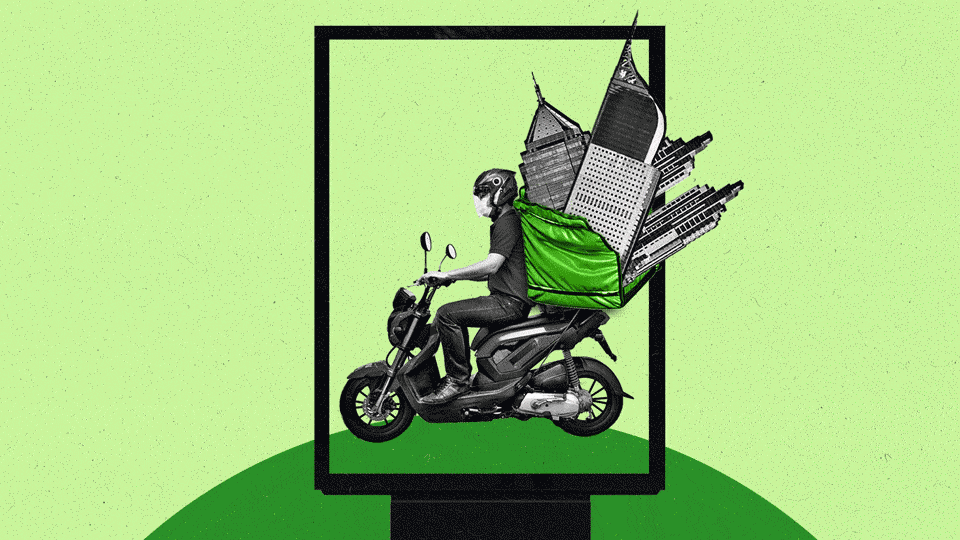How Gojek went from motorcycle delivery service to business juggernaut in Southeast Asia

Illustration by Sarah Kim / Getty / The Current
You could say Gojek started in a Jakarta traffic jam. With its roots in moped delivery services created to cut through that traffic, Gojek today is an essential business platform that leverages data, commerce, and advertising, and in doing so drives two percent of Indonesia’s $1 trillion GDP. It’s an astonishing growth story.
The Indonesian company takes its name from the word ojek, which is what local motorcycle taxis are called in the country. They are often the fastest form of transport in urban areas such as Jakarta, where the average traffic speed is eight kilometers per hour. The founders of the company saw the untapped potential of these two-wheeled taxis and, in 2010, built a call center to connect drivers and riders. But drivers can do more than just transport people. This realization led to the launch of the Gojek app in 2015, which offered three services: ride-sharing, delivery, and shopping. Very quickly, it grew in popularity.
“That was really the key launch, after which everything went extremely fast, where we launched service after service,” Antoine de Carbonnel, the chief commercial officer at Gojek, tells The Current. Those services include GoPay, a digital payment app critical in a country where more than 55 percent of the population are underserved or don’t have a bank account. “Gojek is an answer to a lot of Indonesian consumer pain points.”
Following a meteoric rise, the company is now a multi-service tech platform — some call it a “super app” — that connects merchants, drivers, and customers inside its ecosystem. In an innovative move, it added digital out-of-home (DOOH) screens to some of its moped fleet. In 2021, Gojek merged with e-commerce platform Tokopedia — the Amazon of Indonesia — to create GoTo, combining Gojek’s on-demand and financial tech services with e-commerce. The company serves Indonesia’s 270 million customers, as well as other fast-growing economies in the region. It’s a hyperlocal success that now has international scale. While Gojek creates opportunities for small and medium enterprises (SMEs), driving grassroots economic growth for the lower-middle classes, it has proved itself a pioneer in the region, reaching target audiences across channels on the open internet.
A case in point is the company’s prominent DOOH screens, which are attached to the back of those motorcycle taxis and can “serve as an advertising channel for our merchants,” explains de Carbonnel, running programmatic ads that change according to location and time. Bear in mind that Gojek now has 2.6 million driver partners. “We have a very good idea of the number of eyeballs and the impressions; we have a pretty good idea of the demographics of who is seeing the ads; and we know where our Gojek users are because of the app and can assess which of those users are seeing the ads, which is very important for retargeting,” he says.
Subscribe to The Current
That’s just one channel among several that allow merchants on the Gojek app to find customers.
The company can connect online and offline data, thanks to insights from its suite of services. For instance, when a consumer uses the GoPay app, which is the most-used e-wallet in the country, the company can see where people are buying goods. This allows Gojek’s merchant partners to deploy more targeted advertising and promotional tools, enabling them to attract high-intent users to their merchant page or target users within a specific radius from the store.
Furthermore, Gojek’s unique position in Southeast Asia means it is well placed to offer brands “super measurable” insights into campaigns. For instance, the OMD agency was able to get insights into McDonald’s annual Prosperity Burger ad campaign, which launched for the 2020 Lunar New Year in Indonesia. McDonald’s could measure real-world restaurant sales by linking transactions on Gojek’s GoPay and GoFood apps to a consumer’s exposure to digital media on TV, social media, and streaming platforms. Not only did the campaign deliver a six-fold return on ad spend for the OMD McDonald’s team, they were also able to optimize with real-time data to show a 2,638 percent improvement in ROAS over the course of the three-week campaign.
As a multi-service platform, Gojek can consolidate its consumer touchpoints, journeys, and data. The company — unlike walled gardens — has favored working with a range of partners to enable their data, inventory, and assets inside its ecosystem. “Our approach is very much an open one,” says de Carbonnel. “We can measure the whole funnel, from the number of impressions to the click-through rate to how many people enter the merchant page to how many people put products in their basket to those who check out. And that really drives more visibility and more conversion.”